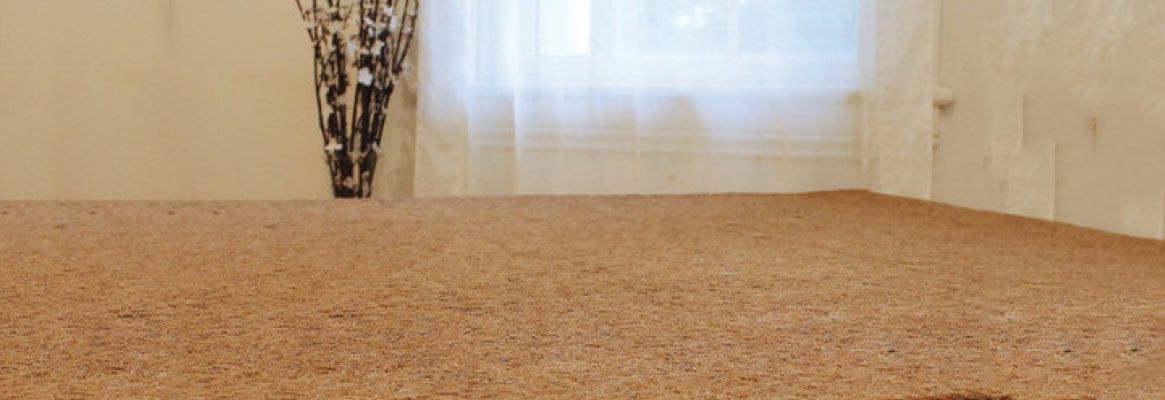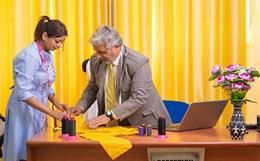Abstract
Jute is a coarse natural fibre. Twotypes of jute are commonly cultivated- corchorus capsularis (white jute) andcorchorus olitorius (tossa jute). Only a small portion of the plant is utilizedfor extracting its fibre (approx 4-6%). An experimental investigation was taken up using this fiberin foundation beds. The tests in plane strain condition were performed on sandwith randomly mixed jute fibers in different percentages of 0.125% to 1.0% byweight of dry sand with aspect ratios of 100 and 150. It has been observed thatthe jute fibres can be used for increase in bearing capacity of soil.
Physical and mechanical properties of jute fibres used inthe study:
The jute fibres used in the study were torn pieces of jutebags and possesed following properties:
Experimental Work
For comparative evaluation of allowable bearing pressure ofvirgin sand and sand with randomly distributed jute fibers, the experimentalwork was conducted in laboratory and results were presented in the form of Loadintensity v/s Settlement plot. The Experimental studies have been done forPlane strain tests conditions on soil with randomly mixed jute fibers. Thetests were conducted with different percentage of jute fibers and at differentaspect ratios.
Material Used For Experimental Work
Soil: The soil used in this study was locallyavailable fine sand taken from locally available Solani River bed near Roorkee.The properties of soil were as below (Table 1). The soil classification was SM.
Table1:Properties of soil used in study:
| Property | Value |
| Dry Density (kN/m3 ) | 16.7 |
| Specific Gravity | 2.61 |
| Uniformity Coefficient, Cu | 1.8 |
| Max. void ratio (emax ) | 0.84 |
| Min. void ratio (emin ) | 0.54 |
| Liquid Limit (%) | Nil |
| Plastic Limit (%) | Nil |
Jute: The jute as available locally was usedfor the study. The lengths of the jute fibres usedfor study were- 60mm (for aspect ratio =10) and 90mm (for. aspect ratio =15)
Test Procedure
All the tests were conducted in plane strain conditions. The test tank (Fig.1) was of dimension 800mmx75mmx350mm. Jute fibers were cut in 60mm and 90mm lengths corresponding to aspect ratios (A.R.s) 10 and 15 respectively to be randomly mixed with soil in various percentages as 0.125%, 0.25%, 0.50% 0.75% 1.0% by weight of soil. The mixed soil was placed in test tank at R.D. =30%. The Load was applied gradually through screw jack attached with Proving Ring of 5.0 kN capacity. The footing of size used in the tests was 75mmx75mm which was made of steel channel. The test was conducted like a normal plate load test till the failure occurred. The settlements were measured for each load applied on footing.
Fig. 1
Test Setup Used For Plane Strain Test Condition
Results and Discussions
Total 11 tests were conducted, 5 nos on each aspect ratio and one for unreinforced soil. The test results are reproduced in Table 2.
The results for these tests were plotted as Load Intensity v/s Settlement curve as shown in Figures 2 to 6. The Figures 7 and 8 show the results with increasing fibre contents for aspect ratios 10 and 15 respectively. The Fig. 9 shows the load intensity versus jute fibre content curve. It has been observed that bearing pressure increases with increase in jute fibres content (Fig. 9). Up to 0.5% jute fibres, there has not been significant improvement with bearing capacity with aspect ratio as 10, but for jute fibre more than 0.5%, the bearing capacity increases significantly for aspect ratio 15 than that for aspect ratio 10.
Table 2: Experimental Results
|
Types of soil |
Allowable bearing pressure (kN/sqm.) |
|
|
Virgin soil |
104.50 |
|
|
Soil with Jute Fibers |
A.R.=10 |
A.R.=15 |
|
Soil+0.125% jute fiber |
135.00 |
142.00 |
|
Soil+0.25% jute fiber |
190.00 |
196.00 |
|
Soil+0.50% jute fiber |
242.00 |
248.89 |
|
Soil+0.75% jute fiber |
371.00 |
444.44 |
|
Soil+1.00% jute fiber |
533.33 |
640.00 |
This increase in bearing pressure is more at higher percentage of jute fibres. At aspect ratio 10, the bearing capacity is about five times and at aspect ratio 15, it is about six times that of virgin soil.
Load Intensity v/s Settlement Characteristics Curves:
Recommendations
Significant improvement in bearing capacity is observed when sand is reinforced with jute fiber. As the jute fiber has significant life (4 to 5 years after rot resistant treatment) and is available at practically no cost, the jute fiber reinforced sand bed can be a reliable foundation for rural housing on soft soils, foundation for temporary structure for the instrument storage, erection of heavy instrument at construction site, highway sub grade etc.
The aspect ratio (AR) as 15 causes more than 6 times increase in bearing capacity, hence can be adopted for sites with confidence. However, the AR as 10 also increases the bearing capacity by 5 times.
The jute fibres quantity by 0.5% of weight of dry soil may double the bearing capacity of virgin soil, hence may be adopted for sites.
The above findings are for the jute properties as mentioned in Table-1, which are the average properties of medium class jute. For higher class jute, the bearing capacity may still increase. However the laboratory model tests are recommended before suggesting its use.
Regulatory Issues & Suggestive Measures for Promotion of Jutes Use
It is evident from the above study that the jute can be used in foundation beds for improvement of bearing capacity of soils. Following are some points which if implemented, may promote not only production but also application of jute:
- By starting degree or diploma courses on jute technology in various technical institutes.
- By developing working models of jutes application in Civil engg. Projects
- By arranging jute application demonstrations for media personalities and technocrats. Short films on jute applications be prepared and distributed. Electronic media be involved in popularizing jute use in engg sector
- By arranging annual conferences on jute application
- By instituting national awards on outstanding project with jutes use
- By providing subsidy/ soft loans on the projects where jute is proposed to be used
- By arranging hands on training to masons for jutes use in engg. Applications
- By establishing jute helpline through internet
- Patents be done for jute application technology, particularly for short term applications in ground improvement techniques
- Research be done for longer life of jute when used with soil
- Preparing a data base of successful projects and dissemination of that in technical institutes
- Preparation of panel of consultants and making it available on line
- Allocation of appreciable funds for Research & Development projects in research laboratories and technical institutions.
References
1) Dey, B., Chand, P. and Singh, J. "Influence of Fibre on The Engineering Properties of soil", IGC-2003 'Geotechnical Engineering for Infrastructure Development' pp 394-399
2) Gosavi Meenal, Patil, K.A., Mittal, Satyendra and Saran, S. "Improvement of Properties of Black Cotton Soil Subgrade through Natural Reinforcement", IGC-2003 'Geotechnical Engineering for Infrastructure Development' pp 379-383.
3) Mehndiratta, H.C., Kumar, Praveen and Padma T., Natural Geotextiles in Highway Embankments-Indian Experience, Indian highways Journal, Vol. 33, No.12, pp 57-66, 2005.
4) Rajagopal, K. and Ramakrishna, S. (1997) Degradation Behaviour of Jute Geotextiles within Clay Soils, Geosynthetic Asia97, 26-29 November, Bangalore, India, pp VI.33-VI.40.
5) Ramakrishna, S. (1996) Investigation on Applications of Jute Reinforcement in Geotechnical Engineering, M.S. Thesis, Deptt. of Civil Engineering, IIT Madras, Chennai.
6) Rao, G.V. and Balan, K. Reinforcing Sand with Jute Fibre, Geosynthetic Asia97, 26-29 November, Bangalore, India, pp VI.183-VI.190.
About the Author:
Dr. Satyendra Mittal is the Associate Professor in Civil Engineering Deptt. I.I.T. Roorkee, India
About the Article:
This article has been written in association with Mr. T. Sanyal who is a Consultant in JMDC, Kolkata, India and Ms. Rachna Vaish, who is associated with NIH, Roorkee.
To read more articles on Textile, Industry, Technical Textile, Dyes & Chemicals, Machinery, Fashion, Apparel, Technology, Retail, Leather, Footwear & Jewellery, Software and General please visit http://articles.fibre2fashion.com
To promote your company, product and services via promotional article, follow
this link: http://www.fibre2fashion.com/services/article-writing-service/content-promotion-services.asp








